Safety Assessment of Gas Pipelines Crossing River through Hydrodynamic Analysis
Abstract
1. Introduction
2. Materials and Methods
2.1. Hydrodynamic Safety Assessment of Buried Gas Pipelines in Riverbeds
2.2. Study Area Description
- = Sediment flux;= Transport parameter;
- = Sediment specific gravity;
- = Median particle size;
- = Effective depth;
- = Shear velocity;
- = Average channel velocity;
- = Transition exponent (based on sediment size)
- which is simple, dimensionless, power function of excess mobility with transport potential as follows:
- = Empirical coefficient;
- = Sediment mobility;
- = Threshold mobility;
- = Empirical power coefficient.
2.3. Numerical Models and Governing Equations
- = Distance along the channel;
- = Time;
- = Flow rate;
- = Cross-sectional area;
- = Lateral inflow unit distance.
- = Acceleration of gravity;
- = Friction slope;
- = Velocity.
- = Water depth;
- = Velocities in Cartesian directions;
- = Cartesian coordinates and time;
- = Density of fluid;
- = Eddy viscosity coefficient
- for xx = normal direction on x axis surface,
- for yy = normal direction on y axis surface,
- for xy and yx = shear direction on each surface;
- = Elevation of bottom;
- = Manning’s roughness;
- = Empirical wind shear coefficient;
- = Wind speed;
- = Wind direction;
- = Rate of Earth’s angular rotation;
- = Local latitude.
- = Concentration;
- = Effective diffusion coefficient in the x-direction;
- = Effective diffusion coefficient in the y-direction;
- = Coefficient for the source term;
- = Equilibrium concentration portion of the source term.
2.4. Composition of Input Data
2.4.1. Assessment of Bed Material Composition and Sediment Load in the Hyunpung Stream
2.4.2. Boundary Conditions for Long-Term Riverbed Change Analysis
2.4.3. Boundary Conditions for Short-Term Riverbed Change Analysis
- = Sediment discharge;
- = Discharge;
- and = Empirical constants.
3. Results
3.1. Long-Term Riverbed Change
3.2. Short-Term Riverbed Change
4. Discussion
5. Conclusions
Author Contributions
Funding
Institutional Review Board Statement
Informed Consent Statement
Data Availability Statement
Conflicts of Interest
References
- Canadian Energy Pipeline Association (CEPA). Pipeline Watercourse Management, Recommended Practices, 1st ed.; CEPA: Calgary, AB, Canada, 2014. [Google Scholar]
- Dooley, C.; Prestie, Z.; Ferris, G.; Fitch, M.; Zhang, H. Approaches for evaluating the vulnerability of pipelines at water crossings. In International Pipeline Conference; American Society of Mechanical Engineers: New York, NY, USA, 2014; Volume 46117. [Google Scholar]
- European Gas Incident Data Group (EGIG). Gas Pipeline Incidents; the 7th EGIG Report; EGIG, 2008. Available online: https://www.egig.eu/reports/$60/$64 (accessed on 8 August 2024).
- The Institution of Gas Engineers. Steel and PE Pipelines for Gas Distribution, 4th ed.; IGE Code TD1; Institution of Gas Engineers & Managers: Derby, UK, 2005; p. 1677. [Google Scholar]
- US Department of Transportation, Pipeline and Hazardous Materials Safety Administration Office of Pipeline Safety (DOT/PHMSA). Mechanical Damage; DOT-Final Report; PHMSA. 2009. Available online: https://www.phmsa.dot.gov/sites/phmsa.dot.gov/files/docs/technical-resources/pipeline/gas-distribution-integrity-management/65991/mechanicaldamagefinalreport.pdf (accessed on 11 September 2024).
- Mokrousov, S. Safety Measures, Regarding Transmission Pipeline Transport in the Russian Federation. In Lecture of Workshop on the Prevention of Water Pollution Due to Pipeline Accidents; 2005; Available online: https://unece.org/fileadmin/DAM/env/documents/2005/teia-wat/cp.teia.2005.1.e.ad.pdf (accessed on 11 September 2024).
- Pipeline Reports; The Transportation Safety Board of Canada (TSB): Gatineau, QC, Canada, 1996.
- Tuft, P.; Bonar, C. Review of Pipeline Incident Data to. 2004. Available online: https://www.pipeliner.com.au/review-of-pipeline-incident-data-to-2004 (accessed on 8 August 2024).
- International Gas Union (IGU), Study Group 3.4. Using or Creating Incident Databases for Natural Gas Transmission Pipelines: A Guideline; IGU: London, UK, 2006. [Google Scholar]
- Park, W.I.; Yoo, C.H.; Shin, D.I.; Kim, T.O.; Lee, H.R. A study on the risk assessment of river crossing pipeline in urban area. J. Korean Inst. Gas 2020, 24, 22–28. [Google Scholar]
- Abada, I.; Massol, O. Security of supply and retail competition in the European gas market. Some model based insights. Energy Policy 2011, 39, 4077–4088. [Google Scholar] [CrossRef]
- Fernandes, M.P.; Viegas, J.L.; Vieira, S.M. Segmentation of Residential Gas Consumers Using Clustering Analysis. Energies 2017, 10, 2047. [Google Scholar] [CrossRef]
- Tchórzewska-Cieślak, B.; Pietrucha-Urbanik, K.; Urbanik, M. Analysis of the gas network failure prediction sing the Monte Carlo simulation method. Eksploat. Niezawodn. 2016, 18, 254–259. [Google Scholar] [CrossRef]
- Tchórzewska-Cieślak, B. Method of Assessing of Risk of Failure in Water Supply System; European Safety and Reliability Conference (ESREL), Risk, Reliability and Societal Safety; Taylor & Francis: London, UK, 2007; Volume 2, pp. 1535–1539. [Google Scholar]
- Królikowska, J. Application of PHA method for assessing risk of failure on the example of sewage system in the city of Cracow. Annu. Set Environ. Prot. 2011, 13, 693–710. [Google Scholar]
- Ondrejka Harbulakova, V.; Estokova, A.; Stevulova, N.; Luptakova, A. Different aggressive media influence related to selected characteristics of concrete composites investigation. Int. J. Energy Environ. Eng. 2014, 5, 82. [Google Scholar] [CrossRef]
- Kent Muhlbauer, W. Pipeline Risk Management; Gulf Publishing Company: London, UK, 1992. [Google Scholar]
- Directive 2009/73/EC of the European Parliament and of the Council of 13 July 2009 Concerning Common Rules for the Internal market in Natural Gas and Repealing Directive 2003/55/EC. Available online: https://eur-lex.europa.eu/legal-content/EN/ALL/?uri=CELEX%3A32009L0073 (accessed on 12 March 2018).
- Tchórzewska-Cieślak, B.; Pietrucha-Urbanik, K.; Urbanik, M.; Rak, J.R. Approaches for Safety Analysis of Gas-Pipeline Functionality in Terms of Failure Occurrence: A Case Study. Energies 2018, 11, 1589. [Google Scholar] [CrossRef]
- Huang, C.; Luo, Y.; Wang, S. Safety assessment method for exposed crossing pipelines caused by river scouring. You-Qi Chuyun 2021, 40, 867–873. [Google Scholar]
- Maffra, C.R.B.; Sutili, F.J. The use of soil bioengineering to overcome scour problems in a pipeline river crossing in South America. Innov. Infrastruct. Solut. 2020, 5, 24. [Google Scholar] [CrossRef]
- Parsaie, A.; Haghiabi, A.H.; Moradinejad, A. Prediction of scour depth below river pipeline using support vector machine. KSCE J. Civ. Eng. 2019, 23, 2503–2513. [Google Scholar] [CrossRef]
- Seth, D.; Manna, B.; Shahu, J.T.; Fazeres-Ferradosa, T.; Pinto, F.T.; Rosa-Santos, P.J. Buckling mechanism of offshore pipelines: A state of the art. J. Mar. Sci. Eng. 2021, 9, 1074. [Google Scholar] [CrossRef]
- Kolahdouzan, F.; Afzalimehr, H.; Siadatmousavi, S.M.; Jourabloo, A.; Ahmad, S. The Effect of Pipeline Arrangement on Velocity Field and Scouring Process. Water 2023, 15, 1321. [Google Scholar] [CrossRef]
- Xia, M.; Zhang, H. Stress and deformation analysis of buried gas pipelines subjected to buoyancy in liquefaction zones. Energies 2018, 11, 2334. [Google Scholar] [CrossRef]
- Fu, H.; Zhang, J.; Wu, Z.; Chin, C.L.; Ma, C.K. Nonlinear analysis of axial-compressed corroded circular steel pipes reinforced by FRP-casing grouting. J. Constr. Steel Res. 2023, 201, 107689. [Google Scholar] [CrossRef]
- Soveiti, S.; Mosalmani, R. Mechanical behavior of buried composite pipelines subjected to strike-slip fault movement. Soil Dyn. Earthq. Eng. 2020, 135, 106195. [Google Scholar] [CrossRef]
- Ismail, S.; Sadek, S.; Najjar, S.; Mabsout, M. Nonlinear fnite element analysis of upheaval buckling of buried ofshore pipelines in medium dense sand with fnes. Innov. Infrastruct. Solut. 2018, 3, 29. [Google Scholar] [CrossRef]
- API RP 1133; Managing Hydrotechnical Hazards for Pipelines Located Onshore or within Coastal Zone Areas. 2nd ed. ACCURIS: Denver, CO, USA, December 2017.
- IGEM–TD/3; Steel and PE pipelines for Gas Distribution, 1 October 2015. Available online: https://cadentgas.com/getmedia/0cd3d877-0a71-45ac-b6e5-fcabe45292d7/F-1-Institution-of-Gas-Engineers-and-Managers-Steel-and-PE-Pipelines-for-Gas-Distribution-IGEM_TD_3-Edition-5-dated-July-20.pdf (accessed on 4 July 2024).
- Australian Standard AS 2885.1:2018; Pipelines—Gas and Liquid Petroleum, Part 1 Design and Construction. ABLIS: Victoria, Australia, 2018.
- CSA Z662-15; Oil and Gas Pipeline Systems Provides Authoritative Safety Guidelines for Kaohsiung’s New Pipeline Standard for Industrial and Urban Safety. Canadian Standards Association (CSA): Rexdale, ON, USA, 17 November 2015.
- Act No. 18814; Urban Gas Business Act. Ministry of Trade, Industry and Energy: Sejong, Republic of Korea, 3 February 2022.
- RMA2 WES Version 4.5; US Army, Engineer Research and Development Center Waterways Experiment Station Coastal and Hydraulics Laboratory. 2008. Available online: http://smsdocs.aquaveo.com/rma2.pdf (accessed on 10 June 2023).
- SED2D WES Version 4.3; US Army, Engineer Research and Development Center Waterways Experiment Station Coastal and Hydraulics Laboratory: 2006. Available online: https://citeseerx.ist.psu.edu/docment?repid=rep1&type=pdf&doi=434913a9c8f6043844541cfac0cad52e1dafc187 (accessed on 11 June 2023).
- Brunner, G.W. HEC-RAS River Analysis System: Hydraulic Reference Manual, Version 5.0. US Army Corps of Engineers–Hydrologic Engineering Center 547: 2016. Available online: https://www.hec.usace.army.mil/software/hec-ras/documentation/HEC-RAS%205.0%20Reference%20Manual.pdf (accessed on 11 June 2023).
- ASME B31.8; Gas Transmission and Distribution Piping System. The American Society of Mechanical Engineers: New York, NY, USA, 2010.
- BS 8010; Code of Practice for Pipelines. British Standard: London, UK, 2004.
- CSA Z662; Oil and Gas Pipeline Systems. Canadian Standard Association: Toronto, ON, Canada, 2003.
- Australia Standard AS 2885; Pipelines-Gas and Liquid Petroleum. Australia Standard: Sydney, Australia, 1987.
- Woo, H.S.; Yu, K.K. Comparative Evaluation of Some Selected Sediment Transport Formulas. KSCE J. Civ. Eng. 1990, 10, 67–75. [Google Scholar]
- Korea Land and Housing Corporation. Hyeonpung River Basic Plan; Korea Land and Housing Corporation: Daegu, Republic of Korea, 2009. [Google Scholar]
- Ackers, P.; White, W.R. Sediment Transport: New Approach and Analysis. J. Hydraul. Div. 1973, 99, 2041–2060. [Google Scholar] [CrossRef]
- Engelund, F.; Hansen, E. A monograph on Sediment Transport in Alluvial Streams; Teknisk Vorlag: Copenhangen, Denmark, 1967. [Google Scholar]
- Yang, C.T. Incipient motion and sediment transport. J. Hydraul. Div. 1973, 99, 1679–1704. [Google Scholar] [CrossRef]
- Yang, C.T. Unit stream power equation for gravel. J. Hydraul. Div. 1984, 110, 1783–1797. [Google Scholar] [CrossRef]
- Yang, C.T.; Wan, S. Comparisons of Selected Bed-Material Load Formulas. J. Hydraul. Eng. 1996, 122, 973–989. [Google Scholar] [CrossRef]
- Woo, H.S.; Yu, K.K. Development of a Guideline for the Selection of Sediment Transport Formulas; Korea Institute of Civil Engineering and Building Technology: Goyang-si, Korea, 1989. [Google Scholar]
- Ministry of Land, Infrastructure and Transport. Commentary on River Design Standards; Ministry of Land, Infrastructure and Transport: Seoul, Republic of Korea, 2019. [Google Scholar]
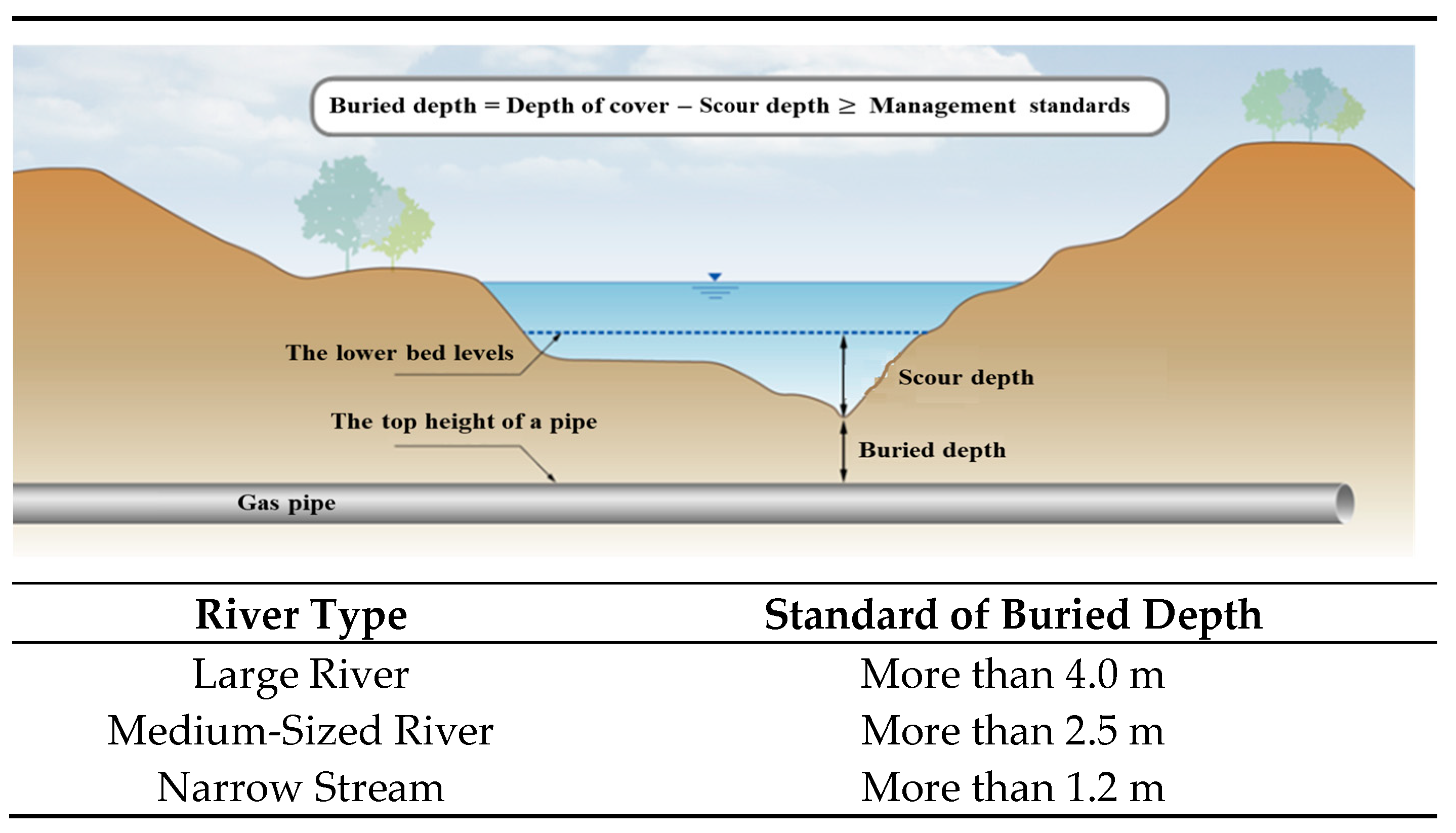

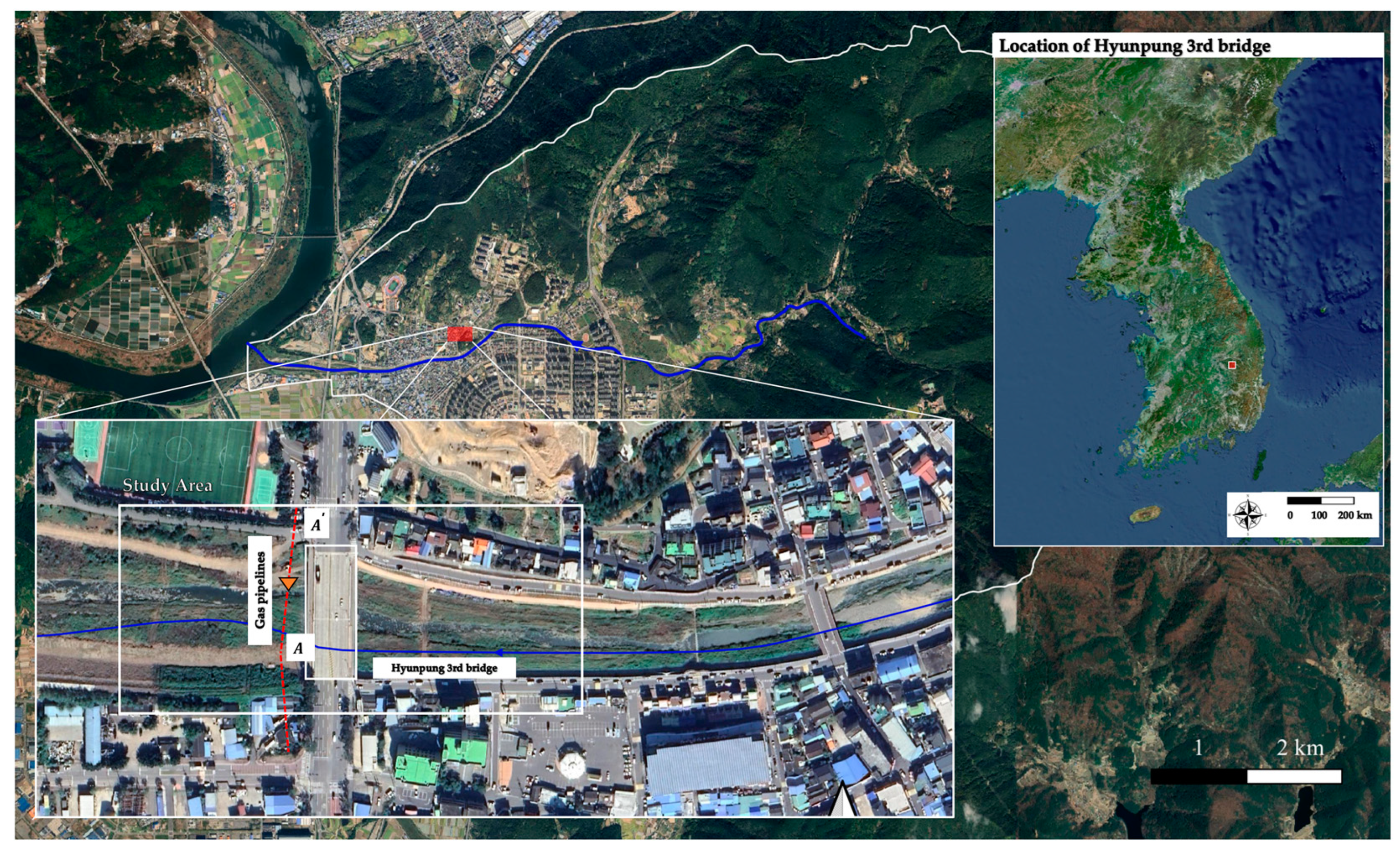


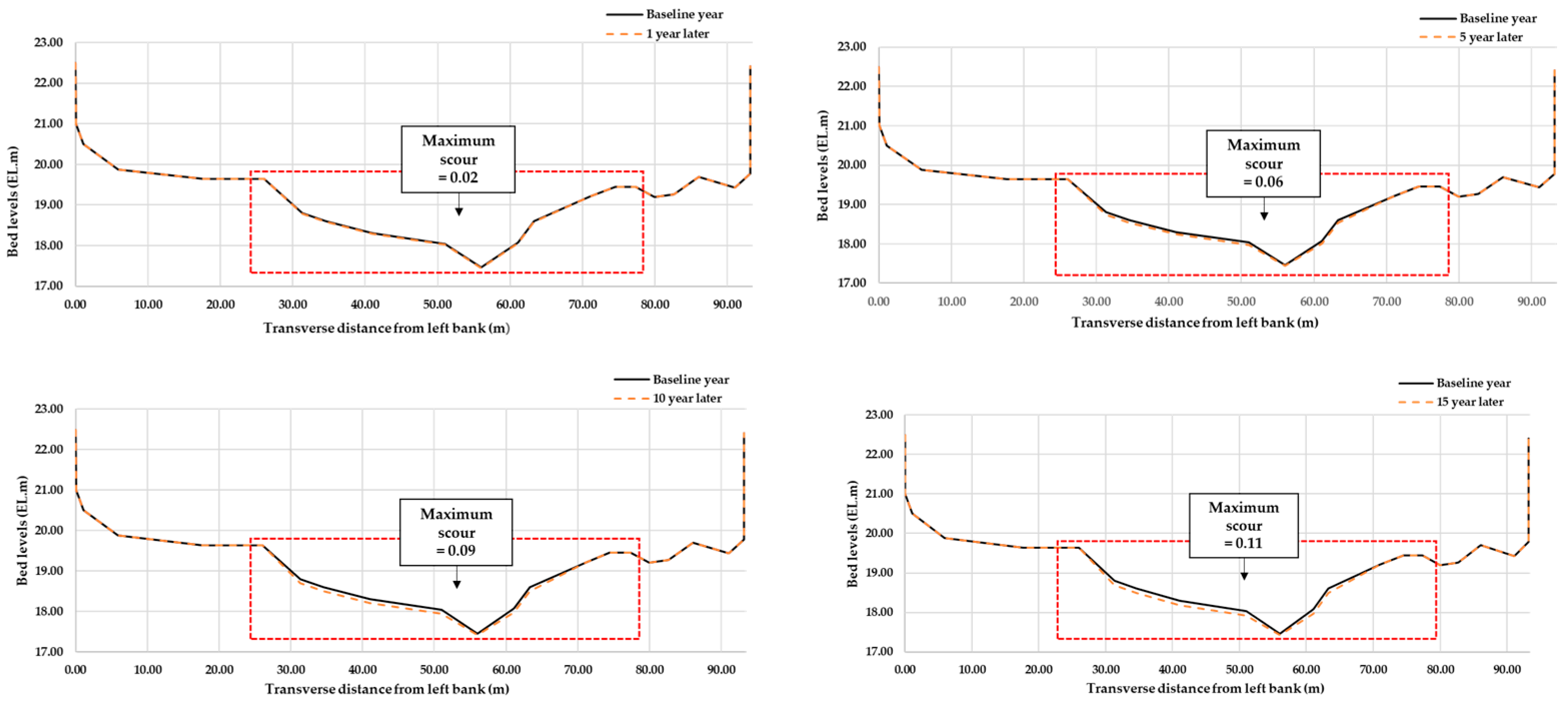

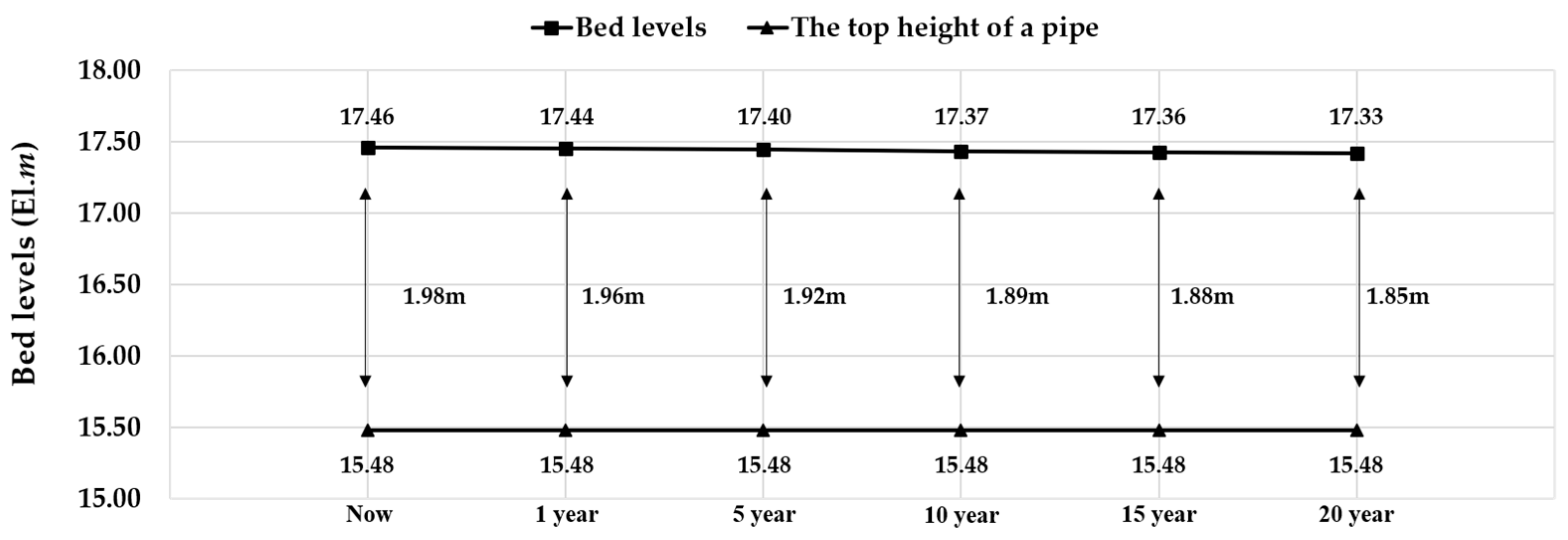
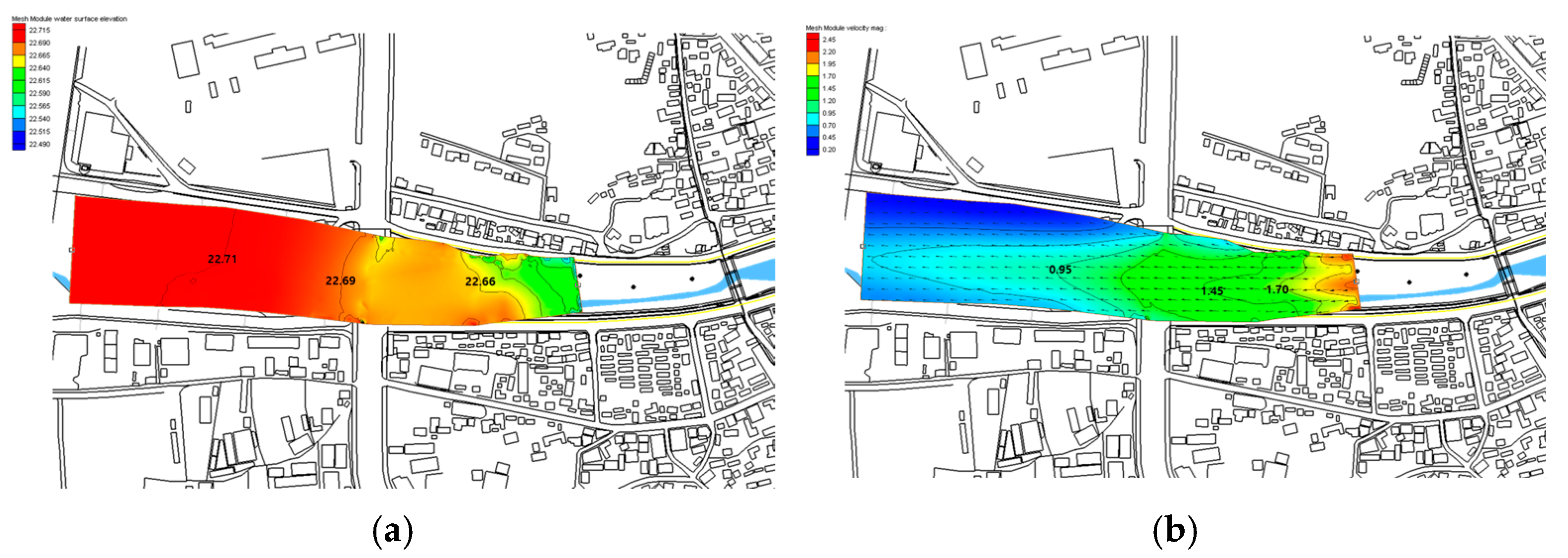


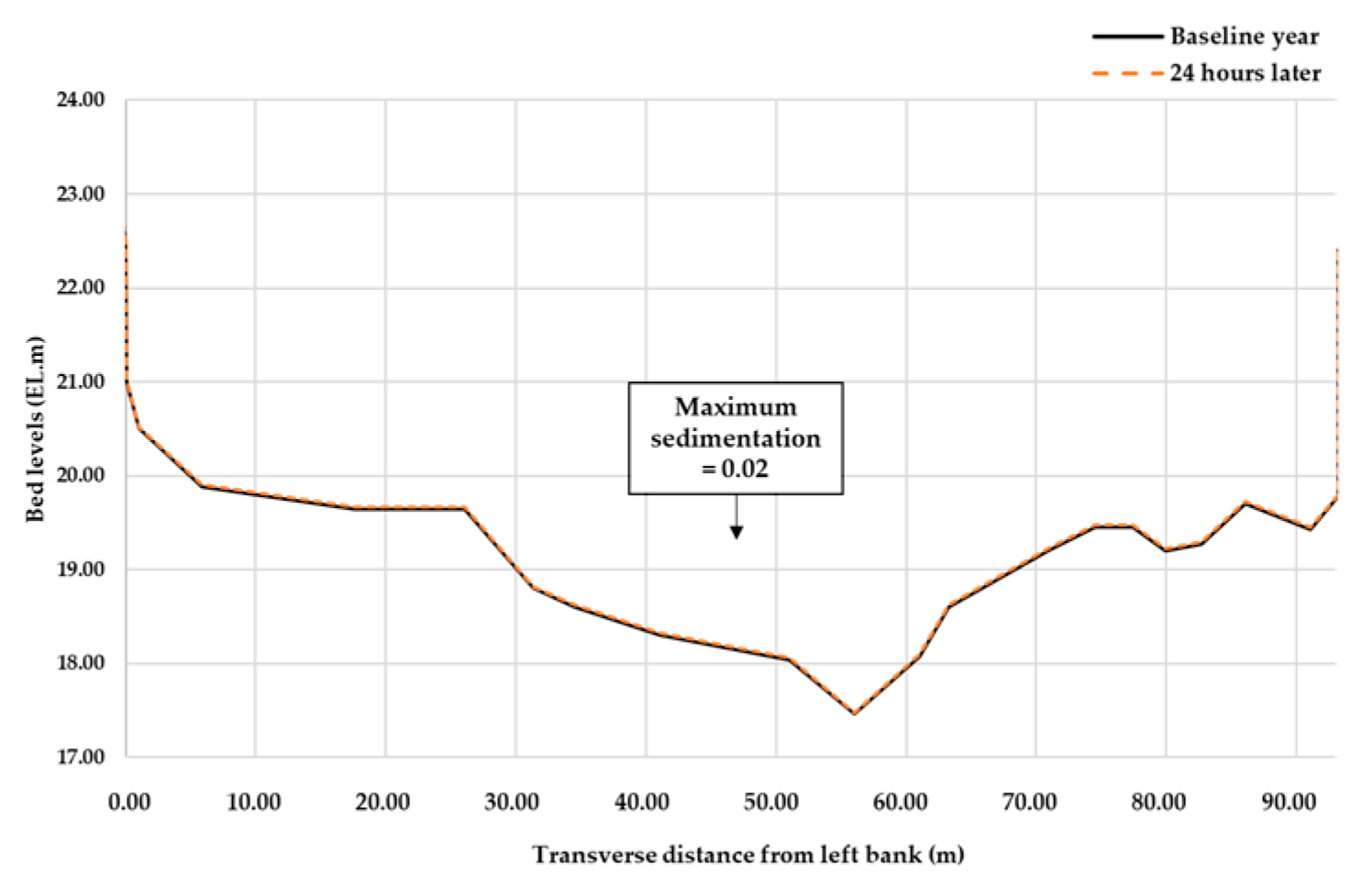

| Cumulative Passing Percentage (%) | ||||||||||||
|---|---|---|---|---|---|---|---|---|---|---|---|---|
| LC (256 mm) | SC (128 mm) | VCG (64 mm) | CG (32 mm) | MG (16 mm) | FG (8 mm) | VFG (4 mm) | VCS (2 mm) | CS (1 mm) | MS (0.5 mm) | FS (0.25 mm) | VFS (0.125 mm) | CM (0.0625 mm) |
| 100 | 94.27 | 74.17 | 50.84 | 34.88 | 29.01 | 27.50 | 26.10 | 9.56 | 6.10 | 3.60 | 1 | 0 |
| Discharge | Upstream of the Simulated Area (m3/s) | Downstream of the Simulated Area (m3/s) | Hyunpung Water Level Gauge (m3/s) | Ackers and White (ton/day) |
|---|---|---|---|---|
| Abundant flow (Q95) | 0.20 | 0.41 | 175.77 | 8.21 |
| Ordinary flow (Q185) | 0.095 | 0.19 | 81.24 | 1.97 |
| Low flow (Q275) | 0.065 | 0.13 | 56.73 | 1.24 |
| Drought flow (Q355) | 0.045 | 0.09 | 38.72 | 0.201 |
| Location | Estimation Methods | Flood Discharge (m3/s) | ||||||
|---|---|---|---|---|---|---|---|---|
| 20 Year | 30 Year | 50 Year | 80 Year | 100 Year | 150 Year | 200 Year | ||
| Hyunpoong Third Bridge point | Clark | 358 | 390 | 428 | 463 | 479 | 509 | 530 |
| NRCS | 420 | 455 | 498 | 537 | 556 | 590 | 614 | |
| Snyder | 274 | 298 | 327 | 354 | 367 | 389 | 406 | |
| Natural River | River and Channel Conditions | Roughness Coefficient Range |
| Flat Small River (No Vegetation) | 0.025–0.033 | |
| Flat Small River (With Vegetation and Silt) | 0.030–0.040 | |
| Flat Small River (With Dense Vegetation and Gravel Bed) | 0.040–0.055 | |
| Mountainous River (With Boulders) | 0.030–0.050 | |
| Mountainous River (With Large Boulders) | 0.040 and above | |
| Large River (With Sand Bed, Subject to Sedimentation) | 0.018–0.035 | |
| Large River (With Gravel Bed) | 0.025–0.040 |
| Measurement Point | Specific Gravity | Sieve Analysis Results (%) | ||||||||||
|---|---|---|---|---|---|---|---|---|---|---|---|---|
| 101.6 (mm) | 76.2 (mm) | 38.1 (mm) | 19.1 (mm) | 9.51 (mm) | 4.75 (mm) | 2.0 (mm) | 0.84 (mm) | 0.42 (mm) | 0.25 (mm) | 0.105 (mm) | ||
| Upstream | 2.62 | 100 | 78.2 | 54.7 | 40.8 | 22.0 | 17.6 | 10.3 | 6.3 | 3.7 | 1.9 | |
| Downstream | 2.62 | 100 | 82.1 | 57.4 | 37.1 | 30.1 | 26.1 | 14.5 | 8.4 | 6.1 | 3.2 | |
| Category | Drop Structure | River Crossing Structure | Sloping Drop Structure |
|---|---|---|---|
| Type |  |  | 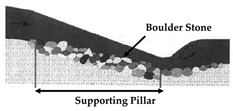 |
| Material | Reinforced concrete | Boulder stone, supporting pillar | Formwork, Boulder stone |
| Flow Type | Containment following reinforced concrete | Creating a gentle slope to maintain the flow | Filling stones along the interior slope of the formwork for riverbed protection |
Disclaimer/Publisher’s Note: The statements, opinions and data contained in all publications are solely those of the individual author(s) and contributor(s) and not of MDPI and/or the editor(s). MDPI and/or the editor(s) disclaim responsibility for any injury to people or property resulting from any ideas, methods, instructions or products referred to in the content. |
© 2024 by the authors. Licensee MDPI, Basel, Switzerland. This article is an open access article distributed under the terms and conditions of the Creative Commons Attribution (CC BY) license (https://creativecommons.org/licenses/by/4.0/).
Share and Cite
Eum, T.S.; Shin, E.T.; Park, J.P.; Song, C.G. Safety Assessment of Gas Pipelines Crossing River through Hydrodynamic Analysis. Appl. Sci. 2024, 14, 9147. https://doi.org/10.3390/app14199147
Eum TS, Shin ET, Park JP, Song CG. Safety Assessment of Gas Pipelines Crossing River through Hydrodynamic Analysis. Applied Sciences. 2024; 14(19):9147. https://doi.org/10.3390/app14199147
Chicago/Turabian StyleEum, Tae Soo, Eun Taek Shin, Jong Pyo Park, and Chang Geun Song. 2024. "Safety Assessment of Gas Pipelines Crossing River through Hydrodynamic Analysis" Applied Sciences 14, no. 19: 9147. https://doi.org/10.3390/app14199147
APA StyleEum, T. S., Shin, E. T., Park, J. P., & Song, C. G. (2024). Safety Assessment of Gas Pipelines Crossing River through Hydrodynamic Analysis. Applied Sciences, 14(19), 9147. https://doi.org/10.3390/app14199147






